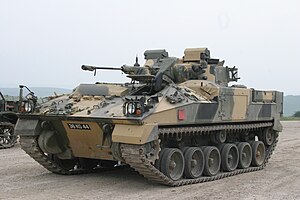Warrior Tracked Armoured Vehicle
| FV 510 Warrior | |
|---|---|

FV510 Warrior Infantry Section Vehicle
|
|
| Type | Infantry fighting vehicle |
| Place of origin | United Kingdom |
| Service history | |
| In service | 1988–present |
| Production history | |
| Designer | GKN Sankey / GKN Defence |
| Manufacturer | GKN Sankey/BAe Systems |
| No. built | 1,000+ |
| Specifications | |
| Weight | 25.4 tonnes |
| Length | 6.3 m (20 ft 8 in) |
| Width | 3.03 m (9 ft 11 in) |
| Height | 2.8 m (9 ft 2 in) |
| Crew | 3 (commander, gunner, driver) + 7 troops |
|
|
|
| Armour | Aluminium and appliqué |
|
Main
armament |
30 mm L21A1 RARDEN cannon (current) |
|
Secondary
armament |
L94A1 coaxial 7.62 mm chain gun 7.62 mm machine gun |
| Engine | Perkins V-8 Condor Diesel 550 hp (410 kW) |
| Power/weight | 23.5 hp/t |
| Suspension | Torsion bar with hydraulic damper |
|
Operational
range |
410 miles (660 km) |
| Speed | 46 mph (75 km/h) on road, 31 mph (50 km/h) off road |
30 mm L21A1 RARDEN cannon (current)
The Warrior tracked vehicle family is a series of British armoured vehicles, originally developed to replace the older FV430 series of armoured vehicles. The Warrior started life as the MCV-80 project that was first broached in the 1970s, GKN Sankey/Defence winning the production contract in 1980. GKN Defence was subsequently purchased by BAE Systems (via Alvis plc). A total of 789 FV510 and variants were manufactured for the British Army, and 254 of a modified version (Desert Warrior) were produced for the Kuwaiti Army.
The Warrior incorporates several design features in keeping with UK battlefield experience. In particular, there are no firing ports in the hull, in line with British thinking that the role of the armoured personnel carrier/infantry fighting vehicle (APC/IFV) is to carry troops under protection to the objective and then give firepower support when they have disembarked. The absence of firing ports also allows additional appliqué armour to be fitted to the sides of the vehicle, which is invariably applied to Warriors involved in active operations. The cage armour used at one stage was replaced in 2007 by "Wrap Two" appliqué armour. The basic armour provides all-around protection against small arms ball ammunition.
The crew of a Warrior comprises the driver, seated in the front hull, and the gunner and commander, who are both seated in the turret. The embarked infantry section can number up to seven soldiers, who are seated facing each other in the rear hull compartment. Passenger access is through a single electric ram powered door at the rear of the hull, rather than a drop-down ramp as in the American M113 APC and M2 Bradley IFV. Warrior Section Vehicles are able to carry and support seven fully equipped soldiers together with supplies and weapons, including a number of anti-tank weapons, for a 48-hour battlefield day in nuclear/biological/chemical conditions.
The Warrior is driven by a Perkins-Rolls-Royce V8 Condor engine through a four-speed automatic gearbox. It is capable of a road speed of 46 miles per hour (74 km/h). The Warrior has the speed and performance to keep up with a Challenger 2 main battle tank over the most difficult terrain.
...
Wikipedia
